The Lewis Acid-Base Concept:Coordination Compounds
| Lewis acid => an electron acceptor |
| Lewis base => an electron donor |
In a Lewis acid-base neutralization, the base donates a pair of electrons forming a coordinate covalent bond which joins the two species together into the reaction product.
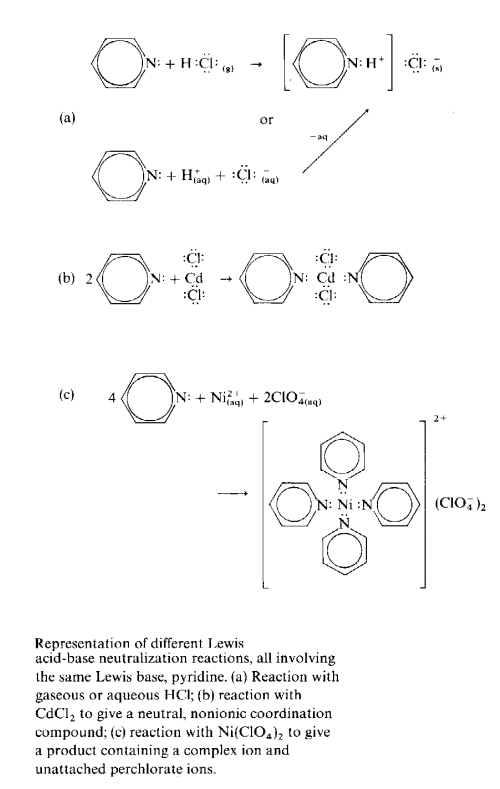
Species which donate electrons are termed Lewis bases, donors or ligands (the organic chemist's nucleophile!) Any atom bearing a lone pair of electrons is capable of being a Lewis base or donor atom.
Species which accept electrons are termed Lewis acids or acceptors (the organic chemist's electrophile!)
The product can be called an acid-base adduct, a coordination complex or coordination compound if it is neutral in charge or a complex ion if there is a resulting charge.
Classification of Ligands
| monodentate | a Lewis base which can form only one bond to a Lewis acid | name means "one tooth" |
| chelating | has more than one donor atom than can form more than one coordinate covalent bond to the same metal ion classified according to the number of donor atoms correctly positioned for potential binding to a Lewis acid  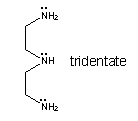
|
non-linear, often with 2 or 3 atoms separating the donor atoms |
| bridging | a can donate more than one pair of electrons to more than one Lewis acid simultaneously | |
| ambidentate | has more than one element that can serve as a donor atom | possesses bridging capability but tends to be monodentate; often linear in geometry |
| macrocyclic | large ring compound with several donor atoms that can bind a Lewis acid inside the ring | |
| pi-donor | donates electrons from a pi bond to a metal ion |
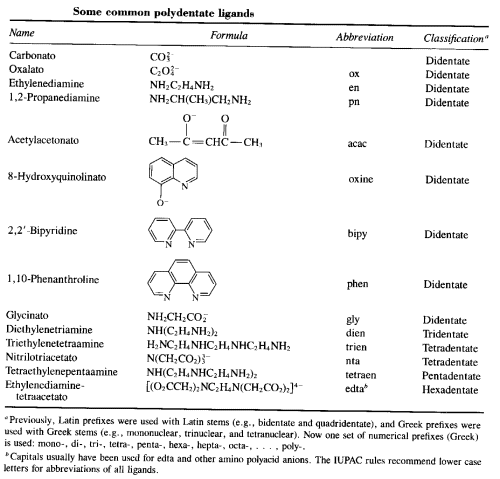
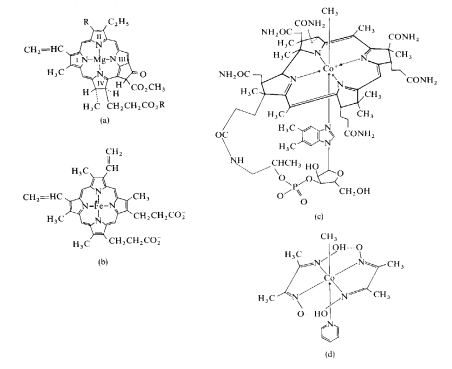
Charged Complexes vs Uncharged Complexes
Charged complex ions and their counterions attract hydration spheres. Since these ions are usually quite large, they typically fall into the nonacidic cation and nonbasic anion categories.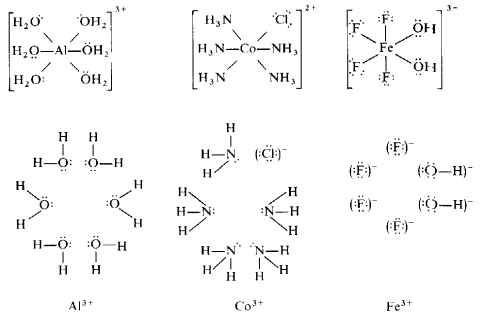
| Ligands in complex ions are often organic or other easily oxidized species. Although perchlorates of these complex cations crystallize nicely, the resulting crystals are dangerously explosive. |
Halo anions such as TiCl6-, BiCl4-,SnCl6-,and SbCl5- can be used for precipitation.
BF4- and PF6- resemble perchlorate in size and basicity but do not involve extremely gihg oxidatin states and are nonoxidizing.
SiF6- resembles sulfate and can be used to precipitate feebly acidic cations.
Uncharged complexes do not attract waters of hydration and are generally insoluble in water unless they contain ligands us as -OH or -NH2 that can H-bond to water.
Uncharged complexes that contain hydrophobic ligands are soluble in nonpolar solvents.
These solubility characteristics can be used in analytical chemistry.
| A metal ion present in very low concentration in a natural water is complexed with an organic ligand to give an uncharged complex which is then extracted into a much smaler volume of nonpolar solvent (separation from impurities and concentrated simultaneously) |
Uncharged complexes tend to accumulate in fatty tissue and lipids and are not excreted in the aqueous urine allowing the complex to build up. When an animal is eaten by another animal higher up in the food chain, the uncharged complex is passed on to the predator. Since the predator eats many of the lower-chain animals, the concentration of the complex builds up (bioamplification of a toxin).
The Chelate and Macrocyclic Effects
Although the number of possible complex ions and compounds formed in a natural water system are very large, there are two generalizations which allow prediction of some of the most likely complexes that will form in a complicated mixture of metal ions and ligands.- Chelate Effect
Chelate ligands form more stable complexes than analogous monodentate ligands - Macrocyclic Effect
Macrocyclic ligands form more stable complexes than chelate ligands
The Chelate Effect
Consider the competition between 1 mole of an n-dentate ligand and n moles of a very similar monodentate ligand for a metal ion by mixing 1 mole of Ni2+ and 6 moles of ammonia and 3 moles of ethylenediamine.[Ni(NH3)6]3+ + 3 NH2CH2CH2NH2
For this equilibrium:
DG = -67 kJ/mol
DH = -13 kJ/mol
(small change since each complex ion involves 6 similar Ni-N bonds)
T DS = -54 kJ/mol
(responsible for the shift favoring complex of chelated ligand)
Macrocyclic Effect
Consider a competition between a noncyclic chelating ligand and a macrocyclic chelating ligand having the same number and type of donor atoms.[K(CH3O(CH2CH2O)5CH3)]+ + cyclo-(CH2CH2O)6
For this equilibrium, Keq = 104.
Thermodynamics of the Lewis Acid-Base Reaction
The enthalpy change for a Lewis acid-base reaction can be predicted using the Drago-Wayland equation.| DH (in kJ/mol) = -4.184 (CACB+EAEB) |

 Calculate the enthalpy changes for the following Lewis acid-base reactions: Calculate the enthalpy changes for the following Lewis acid-base reactions:(a) I2 + ethylacetate (b) SbCl5 + tetrahydrofuran |
The Drago-Wayland equation contains two parameters for each acid and for each base. Neither parameter can be clearly identified with strength in a manner analogous to the Z2/r acid strength relationship.
Both parameters are strength parameters measuring strength of different types.
- E parameters reflect the ability to participate in electrostatic interactions
- C parameters reflect covalent (orbital overlap) tendencies
Comparing CA of I2 to CA of SbCl5 shows SbCl5 is better at covalent bonding than I2.
Comparing EA of I2 to EA of SbCl5 shows SbCl5 is better at covalent bonding than I2.
In this case SbCl5 can be concluded to be an overall stronger Lewis acid than I2 because it is superior in both CA and Ea